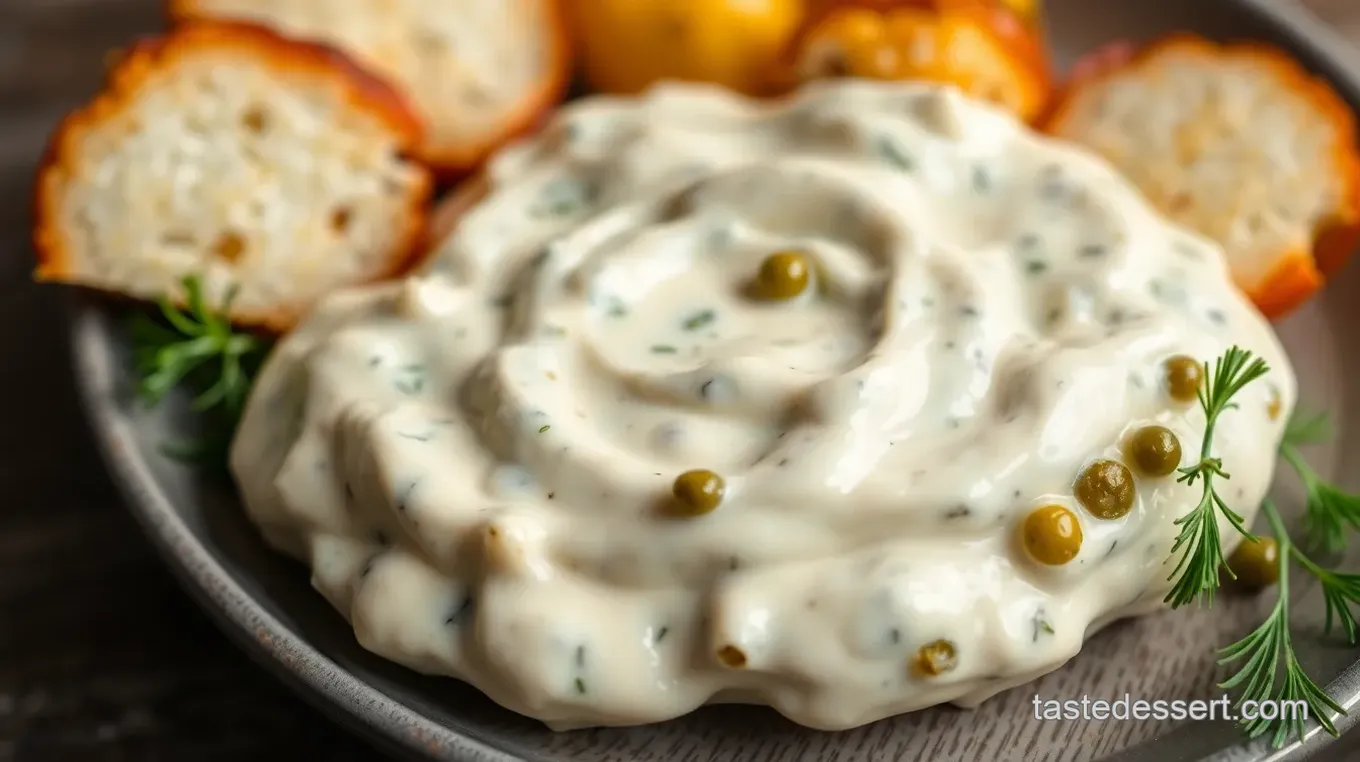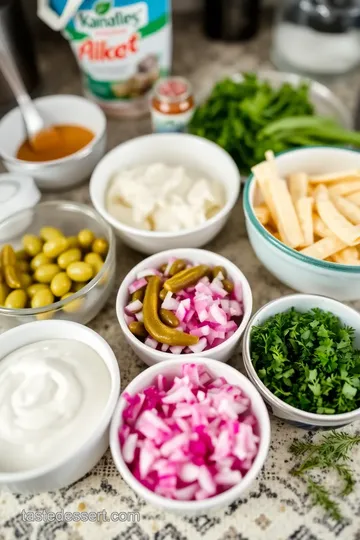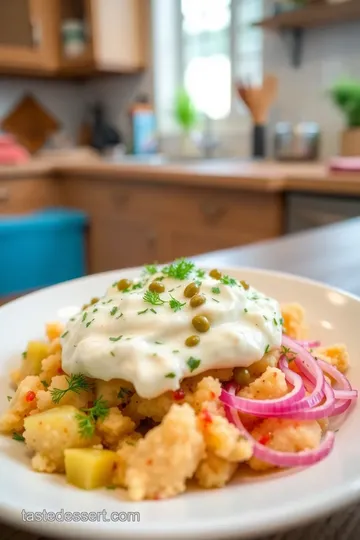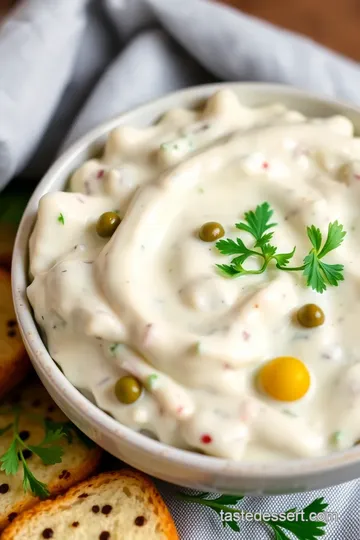Zesty Homemade Tartare Sauce in Just 10 Minutes!
Ever wondered how to mix the best tartare sauce? This zesty homemade recipe comes together in just 10 minutes, perfect for all your seafood dishes!

Mix the Best Tartare Sauce in 10 Minutes
A Quick look into into Flavor
Hey there! have you ever dined out and ordered that crispy fish, and then it just feels wrong when they bring out a sad little condiment? well, let me tell you, i’ve learned that you don’t have to settle for bland store-bought sauces.
A few summers back, i hosted a backyard seafood night, and i had one goal in mind: to mix the best tartare sauce in 10 minutes ! oh my gosh, the look on my friends' faces when they tasted that creamy goodness—pure delight! you have to whip this up for your next gathering.
Now, this ain’t just any old recipe. it’s a quick tartare sauce recipe that carries a bit of history with it.
Tartare sauce originally comes from the cuisine of france, where it gained popularity as the perfect pairing for seafood. nowadays, it’s a go-to for fried fish and even delightful shellfish, making it pretty much a staple on american dinner tables too.
look into Into the Details
You might be thinking, “how can a sauce be that special?” well, let me break it down. this creamy condiment takes only 10 minutes to make and uses simple tartare sauce ingredients you probably already have in your pantry! and trust me, it’s super easy—perfect for anyone at home, whether you’re a seasoned chef or a total newbie in the kitchen.
Your first thought may also be about cost. this tartare sauce won't break the bank! the yield is about 1 cup , enough for 4 servings .
So, whether you’re making a dish for a casual family dinner or a gathering with friends, this sauce is your budget-friendly sidekick!
Benefits That Wow
Now let’s get to the good stuff. besides being a decadent dipping sauce, this easy homemade tartare sauce packs a punch of flavor and nutrients.
Did you know that pickles and capers are loaded with antioxidants? they’re also low in calories! just imagine—this zingy sauce can complement not only your fried fish but also some fresh seafood dilemmas, adding a unique twist.
Think about it for your next crab cakes or shrimp platter; it brightens up each bite!
What about special occasions? this sauce is great for seafood feasts , such as a summer bbq or a cozy date night at home.
Picture this: you’re serving up perfectly crispy calamari or buttery shrimp, and you have a bowl of tartare sauce waiting to elevate each mouthful.
Sounds dreamy, right?
Unlike other sauces, this one can be easily customized to flaunt your signature tartare flavor . toss in some dill or a splash of hot sauce to kick it up a notch.
Trust me; you’ll be the star of your friends’ next potluck!
Ready to Get Mixing?
Alright, let's get started on those fresh tartare sauce ideas so we can make this happen! it’s time to grab those ingredients from your kitchen and whip up that zesty sauce for seafood that you won’t want to live without.
How about we dive into that ingredients section and see just what you need for this delicious adventure? Let’s make it happen!

Essential Ingredients Guide to the Perfect Tartare Sauce
Oh my gosh, if there’s one sauce that elevates seafood from good to unforgettable, it’s tartare sauce . seriously, one minute you’re just having fried fish, and the next, you’ve got this zesty little dollop that takes it to a whole new level! so, let’s dive into the essentials for mixing up the best tartare sauce for fish and make it look effortless.
Premium Core Components
Measurement Magic!
When we talk about ingredients, you don’t want to wing it. Here’s what you need:
- 1 cup (240 ml) mayonnaise (homemade is the best!)
- 2 tablespoons (30 g) capers, drained and chopped
- 2 tablespoons (30 g) dill pickles, finely chopped
- 1 tablespoon (15 ml) lemon juice (fresh, please!)
- 1 teaspoon (5 g) Dijon mustard
- 1 teaspoon (5 g) Worcestershire sauce
- 1 tablespoon (15 g) fresh dill, finely chopped (or 1 teaspoon dried dill)
- And of course, salt and black pepper to taste.
Quality indicators:
freshness is key! look for vibrant colors and fresh aromas. for mayo, a top-notch brand or homemade is always preferable for that creamy texture.
Trust me, you’ll thank your taste buds later!
Storage and shelf life:
once you whip up your quick tartare sauce recipe , it can hang out in the fridge for about a week.
Just be sure to keep it in an airtight container.
Freshness Tips:
Using fresh ingredients like dill and lemon juice makes a world of difference. Also, give your spices a sniff—if they don’t smell strong, it's time to toss 'em out!
Signature Seasoning Blend
Now, let’s talk about flavor, shall we? essential spice combinations like dill, capers, and mustard create that signature tartare flavor.
You can even customize tartare sauce by mixing in other herbs or spices like some chopped green onions or a hint of horseradish for a zing.
Flavor enhancers:
you may want to experiment with some garlic powder, or keep it simple with just salt and pepper.
And oh, don’t forget— if you're feeling adventurous , why not throw in a little hot sauce for a spicy tartare sauce option?
Smart Substitutions
We all forget things sometimes, right? Here are some common alternatives you can use:
- No capers? Use chopped green olives instead.
- Out of dill pickles? Sweet pickles work, but it will be a bit tangier.
- If you want a lighter option, Greek yogurt can replace mayonnaise easily—trust me, it still tastes fabulous!
Emergency replacements:
if you're short on time, you can also grab some pre-made sauces—just try to find one with a bit of freshness to it.
You don’t want anything too bottled and old-school if you're aiming for that creamy condiment for shellfish vibe.
Kitchen Equipment Essentials
Let’s keep it simple, fam. For the equipment, all you need is a mixing bowl, a whisk or spoon, and measuring spoons. No fancy gadgets required!
Preparation tips:
always make sure your ingredients are chopped fine for a smoother texture—no one wants a chunky tartare sauce! and try to taste as you go—it’s like having a mini food adventure right in your kitchen.
Wrapping It Up
So there you have it! the essentials you need to mix the best tartare sauce in 10 minutes . whether it’s served with crispy fried fish, shrimp, or even calamari, it’s a game-changer for your seafood nights.
In just a few minutes, plus a few key components, you'll have a zesty sauce for seafood that will leave your friends and family raving.
Honestly, nothing beats the satisfaction of making an easy homemade tartare sauce that complements your meal perfectly. so grab those fresh ingredients and let’s get to it—you’ll want to keep this easy recipe in your back pocket for sure!
Now, let’s jump into the step-by-step instructions to make this happen! Happy cooking, pals!
Mix the Best Tartare Sauce in 10 Minutes
Oh my gosh, let’s talk tartare sauce , shall we? this zesty homemade tartare sauce is a game-changer! perfect for all your seafood cravings, especially with fried fish or even that shrimp cocktail you’ve been dreaming of.
Plus, you can mix the best tartare sauce in 10 minutes — seriously, 10 minutes and you’re golden!
Essential Preparation Steps
Before you dive into that mixing bowl, let’s chat about some essential prep. first things first, you gotta mise en place — which is just a fancy way of saying, “get your ingredients ready!" gather everything: mayonnaise , capers , dill pickles , and that fresh lemon juice .
It makes things so much easier!
Now, let’s think about time management . i always set a timer while preparing, just so i don’t get distracted scrolling through tiktok and forget to season my sauce.
It's easy—you want to keep it simple and efficient.
Organization is key, friends! i love keeping my cutting board clean and tidy, so i put everything i use right back where it belongs.
And let’s not forget about safety ; keep that knife away from your fingers, okay? no one wants a trip to the er over a tartare sauce mishap!
Step-by-Step Process
Alright, now let’s roll with the fun part — the actual making of this sauce! Here are the quick, clear steps:
- Combine Ingredients : Grab a mixing bowl and toss in 1 cup of mayonnaise .
- Add the Goodies : Stir in 2 tablespoons of chopped capers and 2 tablespoons of dill pickles . The crunch is what makes it divine!
- Flavor Bomb : Squeeze in 1 tablespoon of lemon juice , along with 1 teaspoon of Dijon mustard and 1 teaspoon of Worcestershire sauce . Give it a good mix!
- Herby Goodness : Add 1 tablespoon of fresh dill or 1 teaspoon of dried dill .
- Season It Up : Sprinkle salt and black pepper to taste. Taste it! If it’s not “zingy” enough, go ahead and add more lemon juice.
Hold on — at this point, keep an eye on the clock. You’re still on track for that 10-minute sauce recipe !
Expert Techniques
Here’s where you take it to the next level. one of my favorite tricks? adjust the consistency! if it’s too thick for your liking, just thin it out with a splash of water or more lemon juice.
Simple, right?
Now, let’s talk quality checkpoints . Always check the fresh ingredients. If your pickles are a week old, yikes!
And you know, if you give it a taste and think it’s lacking, don’t be shy about adding a bit of horseradish for a spicy kick! 🎉
Success Strategies
We all make mistakes, and that's totally cool! A common error? Skipping the seasonings. Trust me, it makes a world of difference.
Here’s a quick tip for quality assurance : when in doubt, taste! It’s your sauce; make it to your liking.
And if you wanna get ahead, you can easily make this sauce before your guests arrive. just chill it in the fridge for about 30 minutes to let those flavors marry.
Seriously, a creamier condiment for shellfish can’t get easier!
Wrapping It Up
This classic french tartare sauce is not just for the fancy restaurants anymore. nope! it’s sitting right in your kitchen.
Pair it with crispy fried fish, or use it as a seafood dipping sauce – the choice is yours. honestly, it's the best kind of simple tartare sauce recipe you’ll ever follow.
Don't forget to feel free to customize tartare sauce to your taste; add hot sauce, extra dill, or even swap out the mayo for greek yogurt if you’re watching those calories.
So, the next time you're faced with a plate of fish, whip up this zesty masterpiece in just 10 minutes ! And don’t forget, coming up next, we'll dive into some additional information to keep your seafood game strong!

Digging into the Details of Tartare Sauce
So you want to mix the best tartare sauce in 10 minutes ? you’re in the right place! nothing, and i mean nothing, kicks up a seafood dish quite like a good tartare sauce.
This tangy, creamy delight pairs beautifully with all kinds of seafood—think fried fish, crispy calamari, or even drizzled over shrimp.
Pro Tips & Secrets
When I first started making tartare sauce, I stumbled a bit on the flavors. But after some trial and error, here are my pro tips :
-
Choose Quality Ingredients: If you can, go for homemade mayonnaise —it totally elevates the flavor. But, also, a good store-bought mayo works just fine!
-
Don’t Rush It: Yes, it's a 10-minute sauce recipe , but if you can afford to let it chill for a bit, do it! This helps the flavors marry oh-so-well .
-
Amp Up the Flavor: Feeling a little adventurous? Toss in some horseradish or hot sauce for that zesty kick. I once added a few dashes of hot sauce, and whoa, it became a favorite at my house!
-
Presentation is Key: In the culinary world, we eat with our eyes first, right? So serve your tartare sauce in a cute bowl, topped with a sprinkle of fresh dill .
Perfect Presentation
Let’s talk plating ! You want that sauce to shine, right? Here are some ideas:
-
Color Combos: White sauce on a colorful plate is the way to go. The contrast just looks fab!
-
Garnish Wisely: A sprig of fresh dill on top adds that gourmet touch. Just don’t go overboard; less is more!
-
Plating Techniques: Create a little swirl with your sauce using a spoon. Simple, yet it makes it look intentional and classy.
Storage & Make-Ahead
Okay, here’s the scoop on keeping your sauce fresh:
-
Storage Guidelines: Pop your tartare sauce into an airtight container. It should be good in the fridge for about 3-5 days . Just give it a quick stir before serving again!
-
Reheating Instructions: This sauce is meant to be served cold, so no reheating here! Keep it chill for the best flavor.
-
Freshness Duration: It’s seriously best when fresh, but you can prep it a day ahead for time-saving.
Creative Variations
Feeling fancy ? Let’s shake things up with some variations:
-
Flavor Adaptations: Swap out those dill pickles for sweet ones if you're into a sweeter tartare sauce. Personally, I love how that balances out with fried fish.
-
Seasonal Twists: In summer, try adding some minced fresh basil ; it gives a whole new vibe that is just divine with shrimp!
-
Dietary Modifications: Need a lower-calorie option? Use Greek yogurt as a base. It may not be traditional, but the flavor is still on point!
Complete Nutrition Guide
Now, let’s get real for a minute. Here’s a rough breakdown of what's in your easy homemade tartare sauce per serving:
-
Calories: About 120
-
Fat: Mostly from the mayo, which can vary based on what you choose.
-
Protein: A whopping 1g! Don’t expect it to be a protein powerhouse though.
-
Dietary Considerations: If you’re watching sodium, be mindful of how much Worcestershire sauce you add.
Expert FAQ Solutions
You might be thinking, “Can I customize this?” Absolutely! Here are answers to some burning questions:
-
How can I make it spicier? Just whip in some hot sauce!
-
What if I don’t have capers? Green olives can step in here without missing a beat.
-
Can I make this ahead? You sure can! Just remember to let it chill.
All in all, making a zesty and creamy tartare sauce at home doesn’t have to be complicated, and it certainly doesn’t need to take long.
I've had my fair share of cooking mishaps—over-mixing, salty disasters, you know the drill. but honestly, once you master this simple tartare sauce ingredient list, you'll feel like a kitchen pro.
So dive into this creamy condiment for seafood and enjoy every last bite. Your fish dishes will thank you, and your friends will think you’re a total rockstar. Happy cooking!

Zesty Homemade Tartare Sauce in Just 10 Minutes! Card

⚖️ Ingredients:
- 1 cup (240 ml) mayonnaise
- 2 tablespoons (30 g) capers, drained and chopped
- 2 tablespoons (30 g) dill pickles, finely chopped
- 1 tablespoon (15 ml) lemon juice, freshly squeezed
- 1 teaspoon (5 g) Dijon mustard
- 1 teaspoon (5 g) Worcestershire sauce
- 1 tablespoon (15 g) fresh dill, finely chopped
- Salt and black pepper to taste
🥄 Instructions:
- Step 1: In a mixing bowl, add 1 cup mayonnaise.
- Step 2: Stir in 2 tablespoons chopped capers and 2 tablespoons chopped dill pickles.
- Step 3: Pour in 1 tablespoon lemon juice, 1 teaspoon Dijon mustard, and 1 teaspoon Worcestershire sauce.
- Step 4: Mix well until all ingredients are incorporated.
- Step 5: Add 1 tablespoon fresh dill to the mixture and season with salt and black pepper to taste.
- Step 6: Taste the tartare sauce and adjust any seasonings as needed.
- Step 7: Transfer the tartare sauce to a serving dish
Previous Recipe: How to Mix Sweet Chilli Sauce with Tangy Lime for an Amazing Dip
Next Recipe: My Favorite No-Cook Mango Salad with Sweet Chili Lime: A Tropical Delight
